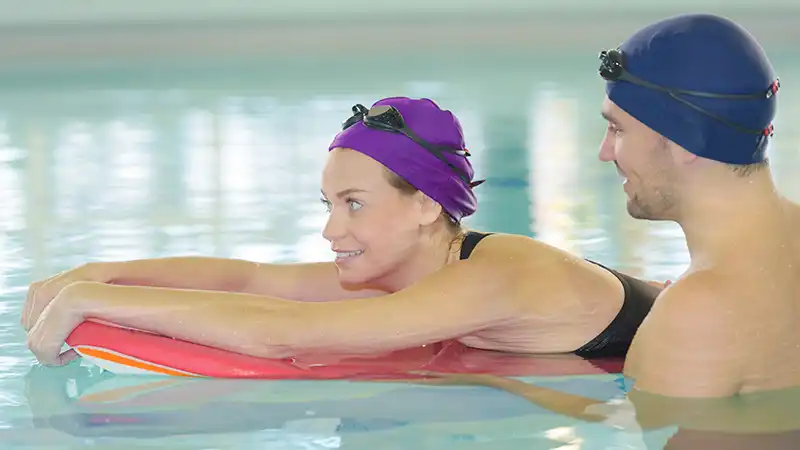If you’re recovering from a shoulder injury, you may wonder is swimming good for shoulder injuries?
The answer is not always straightforward.
While swimming can be a great way to strengthen your shoulder muscles and improve your range of motion, it can also exacerbate certain types of shoulder injuries.
That being said, there are many cases where some swimming can be a beneficial form of exercise for those with shoulder injuries.
In fact, some physical therapists recommend swimming as rehabilitation for certain shoulder injuries as it allows you to work your muscles without putting too much stress on your joints.
Swimming can also help improve your posture and balance, which can reduce your risk of future injuries.
Understanding Shoulder Injuries
Shoulder Anatomy

To understand shoulder injuries, it’s important to first understand the anatomy of the shoulder. The shoulder is a complex joint made up of bones, muscles, tendons, and ligaments.
It’s designed to be highly mobile, allowing for a wide range of motion, but this also makes it vulnerable to injury.
The shoulder joint comprises three bones: the humerus, scapula, and clavicle.
The humerus is the upper arm bone, the scapula is the shoulder blade, and the clavicle is the collarbone.
A network of muscles, tendons, and ligaments holds these bones together.
The rotator cuff is a group of four muscles and their tendons that connect the humerus to the scapula. These muscles help to stabilize the shoulder joint and allow for movement.
Common Shoulder Injuries
There are many types of shoulder injuries, but some of the most common include:
- Rotator cuff tears: A tear in one or more of the rotator cuff tendons can cause pain, weakness, and limited range of motion.
- Shoulder impingement: This occurs when the tendons of the rotator cuff become pinched between the bones of the shoulder, causing pain and inflammation.
- Frozen shoulder: Also known as adhesive capsulitis, this condition causes stiffness and pain in the shoulder joint.
- Shoulder bursitis: Inflammation of the bursa, a small fluid-filled sac that cushions the joint, can cause pain and swelling.
- Shoulder dislocation: This occurs when the upper arm bone pops out of the shoulder socket, causing pain and instability.
A variety of factors can cause shoulder injuries, including overuse, trauma, and degenerative conditions.
Treatment options depend on the type and severity of the injury, but may include rest, physical therapy, medication, or surgery.
It’s important to seek medical attention if you experience any pain or discomfort in your shoulder, as early intervention can help prevent further damage and improve outcomes.
Swimming as a Rehabilitation Exercise

If you have a shoulder injury, swimming can be an excellent way to rehabilitate and strengthen the affected area – as long as you start slowly and gradually increase the intensity.
Here are some benefits of swimming for shoulder injuries and some swimming techniques that can help with rehabilitation.
Benefits of Swimming for Shoulder Injuries
Swimming is an excellent low-impact exercise that can help you stay active while recovering from a shoulder injury.
Here are some benefits of swimming for shoulder rehabilitation:
- Water buoyancy reduces the impact and stress on your shoulder, allowing you to exercise without putting too much pressure on the affected area.
- Water resistance can help build muscle strength and improve your range of motion.
- Swimming can also improve your cardiovascular health, which can help with overall recovery and rehabilitation.
Swimming Techniques for Shoulder Rehabilitation
When swimming for shoulder rehabilitation, it’s important to use proper techniques to avoid further injury.
Here are some swimming techniques that can help with shoulder rehabilitation:
- Use swim fins when swimming freestyle or backstroke to help reduce shoulder muscle strain.
- Use a breaststroke or backstroke with a flutter kick to reduce the pressure on your shoulders and focus on your lower body.
- Use a kickboard to focus on your lower body and reduce the pressure on your shoulders. If stretching your arms forward to the kickboard hurts your shoulders, lie on your back and hug the board.
- Avoid butterfly strokes, as they can put too much stress on your shoulders.
Besides these techniques, you can also try using aquatic dumbbells or resistance bands to add resistance to your water workouts and help build strength in your shoulders.
Overall, swimming can be an excellent way to rehabilitate and strengthen your shoulders after an injury.
By using proper techniques and taking it slow, you can help speed up your recovery and get back to your normal activities sooner.
Preventing Further Shoulder Injuries While Swimming

If you have experienced shoulder injuries in the past, it is important to prevent further injuries while swimming.
Here are some tips to help you swim without causing further damage to your shoulders.
Proper Warm-up and Stretching
Before swimming, it is very important to warm up and stretch your shoulders.
This will help to increase blood flow, loosen up your muscles, and prepare your body for the exercise.
A good warm-up should last at least 10 minutes and include some light cardio exercises, such as jogging or jumping jacks.
After warming up, stretch your shoulders by performing exercises that target the rotator cuff muscles and the muscles in your upper back.
Stretching can help to increase your range of motion, reduce muscle tension, and prevent injuries.
Some good stretches for swimmers include arm circles, shoulder blade squeezes, and pec stretches.
Technique and Body Mechanics
Proper technique and body mechanics are essential for preventing shoulder injuries while swimming.
Make sure that you are using the correct swimming technique, which involves keeping your shoulders relaxed and your arms close to your body.
Avoid overreaching or over-rotating your shoulders, as this can put too much strain on your shoulder joints.
In addition, it is important to maintain good posture while swimming. Keep your head up, your shoulders back, and your chest open.
This will help to reduce the strain on your shoulders and prevent injuries.
Strengthening and Stabilizing Exercises
Strengthening and stabilizing exercises can help to prevent shoulder injuries by improving the strength and stability of your shoulder muscles.
Some great exercises for swimmers include scapular pushups, shoulder blade squeezes, and rotator cuff exercises.
It is important to start light and gradually increase the intensity of your exercises. Don’t push yourself too hard, as this can lead to injuries.
Always listen to your body and stop if you feel any pain or discomfort.
By following these tips, you can prevent further shoulder injuries while swimming.
Remember to warm up and stretch, use proper technique & body mechanics, and perform strengthening and stabilizing exercises.
With these steps, you can enjoy the many benefits of swimming without putting your shoulders at risk.
Consult With Your Doctor
As with any new exercise, always be sure to consult with your doctor or physical therapist before swimming with shoulder injuries!
